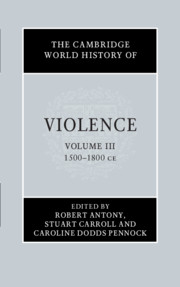Book contents
- The Cambridge World History of Violence
- The Cambridge World History of Violence
- The Cambridge World History of Violence
- Copyright page
- Contents
- Figures
- Maps
- Contributors to Volume iii
- Introduction to Volume iii
- Part I Empire, Race and Ethnicity
- 1 Terror, Horror and the British Atlantic Slave Trade in the Eighteenth Century
- 2 Violence, Slavery and Race in Early English and French America
- 3 Race and Violence in Portuguese America
- 4 Violence and Religion in the Ottoman Empire
- 5 Human Sacrifice, Ritualised Violence and the Colonial Encounter in the Americas
- Part II Cultures of War and Violence
- Part III Intimate and Gendered Violence
- Part IV The State, Punishment and Justice
- Part V Popular Protest and Resistance
- Part VI Religious and Sacred Violence
- Part VII Representations and Constructions of Violence
- Index
- References
4 - Violence and Religion in the Ottoman Empire
molly greene
from Part I - Empire, Race and Ethnicity
Published online by Cambridge University Press: 13 March 2020
- The Cambridge World History of Violence
- The Cambridge World History of Violence
- The Cambridge World History of Violence
- Copyright page
- Contents
- Figures
- Maps
- Contributors to Volume iii
- Introduction to Volume iii
- Part I Empire, Race and Ethnicity
- 1 Terror, Horror and the British Atlantic Slave Trade in the Eighteenth Century
- 2 Violence, Slavery and Race in Early English and French America
- 3 Race and Violence in Portuguese America
- 4 Violence and Religion in the Ottoman Empire
- 5 Human Sacrifice, Ritualised Violence and the Colonial Encounter in the Americas
- Part II Cultures of War and Violence
- Part III Intimate and Gendered Violence
- Part IV The State, Punishment and Justice
- Part V Popular Protest and Resistance
- Part VI Religious and Sacred Violence
- Part VII Representations and Constructions of Violence
- Index
- References
Summary
The stereotype of the ‘terrible Turk’ has long existed alongside the romantic view of a multicultural, cosmopolitan Ottoman Empire. Assertions of Ottoman ‘tolerance’ have been very enduring even in the academic literature. In recent decades Ottoman historians have worked hard to historicise both violence and more peaceful relations, between both state and society and within society itself. Tolerance is now better understood as a strategy of rule rather than a value in and of itself. In addition, this was a far-flung empire that lasted for over 600 years, and no one model can hold for all places and all times within the sultan’s domains. Beginning with the Ottoman conquest of the Balkans in the fourteenth century, this chapter considers not only more familiar topics, such as non-Muslim conversion to Islam, but also highlights the fact that most religious persecution in the empire, when it occurred, was directed at non-conforming Muslims, however defined. The rise of the Shi’a Safavid Empire in the east and the ruling elite’s close relationship to Sufi Islam were both major sources of tension and, at times, outright violence. At the same time, communal elites usually shared a strong interest in the maintenance of religious boundaries; this attitude contributed to social peace.
- Type
- Chapter
- Information
- The Cambridge World History of Violence , pp. 77 - 95Publisher: Cambridge University PressPrint publication year: 2020

